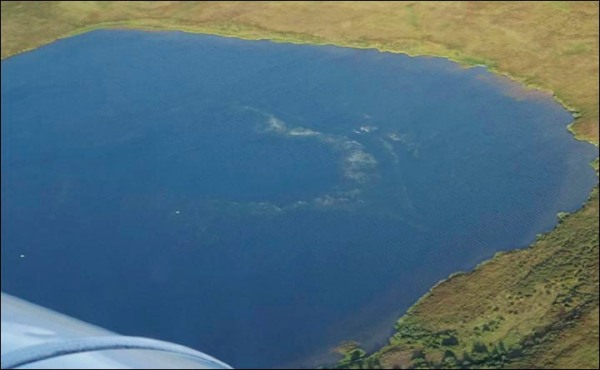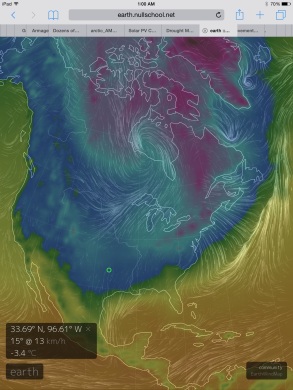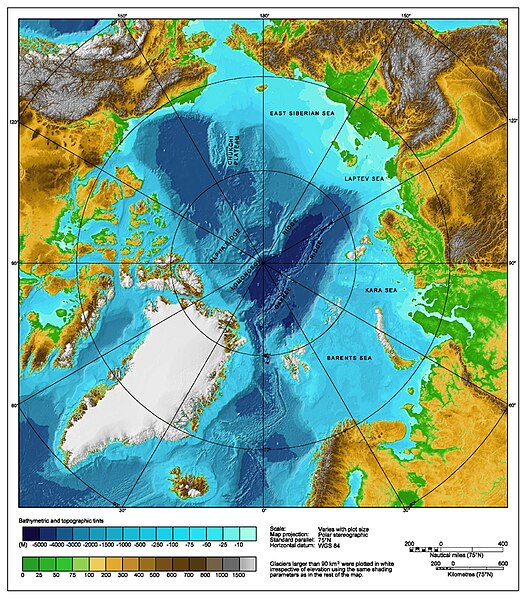Abrupt Climate Change, Already?by Robert Hunziker / January 30th, 2015
Is abrupt climate change already here?
There are some serious scientists who believe it is already here. If their analysis is correct, the world could turn nearly uninhabitable within current lifetimes.
In that regard, the American public is overly, dangerously casual about the prospects/risks of abrupt climate change. This is found in numerous studies and polls; e.g., according to a Pew Research Global Attitudes Project, in an international survey of 39 countries, Americans were among the least concerned about climate change threatening the country. Global warming also ranked near the bottom of Americans’ priorities.
As it goes, the American public may be caught off guard, unprepared, and ill equipped to press its political establishment for appropriate action because abrupt climate change has a history of happening very, very quickly, within decades, not over hundreds of years.
Assuming these scientists are correct, by the time the U.S. Congress gets serious about climate change, they’ll be wearing waders.
As for the risks associated with abrupt climate change, according to Paul Beckwith, Laboratory for Paleoclimatology and Climatology, University of Ottawa, in the past:
The temperature of the planet has increased by 5C or 6C within one decade or two decades… not within a hundred years but within one or two decades… during the ice age period between 70,000 and 40,000 years ago, the temperature rose over Greenland 5-6C in a decade or two… and 55 million years ago… the temperature rose globally by 5C in 13 years, as shown in sediment samples. (COP20: Global Arctic Methane Emergency)
Based upon historic records, once abrupt climate change commences, and when viewed on a geological-time basis, it has the potential to take off like a house on fire. According to Paul Beckwith, unfortunately: “We’re undergoing the early stages of abrupt climate change,” already, right now! As such, a rapid self-fulfilling temperature rise of 5C or 6C would be devastating for life as we know it.
This risk of further rapid abrupt climate change, as, for example, temperatures zooming upwards, depends upon the integrity of the ice of the Arctic, among other considerations. As emphasized by Beckwith, when analyzing the climate system, it is important to understand that metrics can be misleading. For example, the consensus opinion talks about 2C as a cap for rising temperatures; however, in point of fact, “What is important is the temperature distribution on the planet on a latitudinal basis.”
Beckwith: “The Arctic is absorbing a lot more solar energy, and by itself at a much greater rate, than anywhere else on the planet. In fact, on average, in the last number of decades, the Arctic temperature has risen 1.0C per decade whereas the global average temperature rise has been about 0.15C per decade. So that ratio is 6 or 7 times more.”
Therefore, the most immediate risk of further abrupt climate change hinges on how well the Arctic withstands global warming. As the Arctic loses ice mass, it releases more, and more, methane (CH4), which is much more powerful at entrapping heat than is carbon dioxide (CO2), and because massive quantities of CH4 are embedded within the ice, only a small fraction may cause the planet to heat up rapidly, going into deadly overdrive, resulting in numerous outgrowths negatively impacting life. As, for example, rapid increase in sea levels, flooding coastal cities, embedded droughts, diminishing agricultural production, severe storm activity, and horrific heat throughout the mid latitudes, resulting in panic, illness, and sudden death. It is likely the world turns chaotic.
Scientists are radically divided on the issue of abrupt climate change and few predict an upsurge any time soon. Nevertheless, it’s the scientists who base their opinion on first hand knowledge, “boots on the ground,” who are screaming the loudest. They do not let the “ computer models” override what they personally experience. In contrast, they see and feel the reality “in the field.” They are like scientific pioneers in the field, in the marsh, below and above the ice, on expeditions into the wilderness where nobody cares to tread. It’s hard work.
Those scientific pioneers, like John Nissen, Chairman of the Arctic Methane Emergency Group (AMEG), are deeply concerned about the rate of melt of the Arctic, and the attendant enormous plumes of methane, already observed in the Arctic seas, especially in the East Siberian Ice Shelf where waters are shallow and easily warmed, threatening to release gigatons of methane. Expeditions above, below, and on the surface have convinced these scientists that we’ve got a huge problem coming up, maybe soon, maybe too soon.
According to John Nissen: “Sea ice could disappear at the end of summer as soon as next September. At that point, further warming of the Arctic, sea level rise, methane release, in that time bomb, and abrupt climate change, could become unstoppable. The fuse will have been lit and will be going off very quickly. We consider it an absolute scandal that IPCC [Intergovernmental Panel on Climate Change] says nothing about the greatest threat to humanity since civilization began.”
In turn, these pioneering scientists listen to other scientists who also favor “boots on the ground” analysis over scientific modeling, people like Dr. Natalia Shakhova, who leads the Russia-U.S. Methane Study at the International Arctic Research Center, at the University Alaska Fairbanks and the Pacific Oceanological Institute, Far Eastern Branch of Russian Academy of Sciences. Dr. Shakhova’s expeditions to the Arctic convince her that only a tiny percentage of the vast amounts of methane buried in Arctic ice is necessary to double current atmospheric CH4. Worse yet, she suspects an outburst of 50 gigatons could happen at any time. In many respects, this would be a disaster beyond repair.
In an interview, Shakhova says, “We do not like what we see… absolutely do not like it.”
In the end, too much carbon dioxide emitted by burning too much gas, oil & coal, blankets the atmosphere enough to heat up the Arctic far above and way beyond past centuries, causing torrential weather patterns throughout the Northern Hemisphere, and shaking lose too much methane for human comfort.
Could civilization withstand a 50-gigaton release? Professor Wadhams’ response is: “No, I don’t think it can.”
Is there a solution?
Yes, there may be solutions but according to these scientists, a sense of urgency matters more than anything at this late hour.
Paul Beckwith is one of the scientific pioneers, an advocate, a researcher, and member of AMEG, co-founded by Peter Wadhams, professor of Ocean Physics, University of Cambridge.
Beckwith: “We have to slash emissions there’s no question, slash the CO2 emissions and quickly, but that’s not sufficient. We also have to cool the Arctic, and we also have to try to remove CO2 from the atmosphere.”
The technology is there, solar radiation management, reflecting incoming solar, and sea salt spraying, as well as employing concerted efforts to increase vegetation to absorb CO2, and carbon capture, and biochar.
However, there’s risk because nobody has proven these geoengineering techniques effective on a planetary scale. On that basis, they are experimental. There is no consensus in the world community to test geoengineering, which is very provocative subject matter amongst scientists, some favor, some oppose. And, those opposed adamantly oppose because of potential harmful feedback loops. It may be a risky venture.
But, what if these early-warning scientists are wrong? What if they are absolutely correct about the outcome of global warming/climate change but too optimistic about the timing? This, therefore, is all the more reason for governments to initiate conversions now from fossil fuels to renewables, hopefully rescuing future generations from the potential of a global warming nightmare.
If we lose the ice caps, civilization starves and the world’s coastal cities drown. It’s really as simple, and complex, as that. Already, CO2 levels are at an historic high.
Throughout geological history, “Every time we have hit high CO2, we’ve lost the ice caps,” Peter Ward, professor, Dept. of Earth & Space Sciences, University of Washington, Our Future in a World without Ice Caps, 2013 lecture series.
















